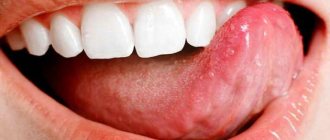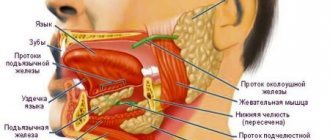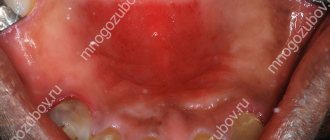Tongue cancer is a fairly common pathology in the structure of malignant neoplasms of the head and neck organs (about 55% of cases), and in the general structure of malignant neoplasms it accounts for 0.45%. The average age of those affected is 60 years, men suffer from it 3 times more often than women. But the tumor can also occur in young people and even children.
- Causes of tongue cancer
- Symptoms of tongue cancer
- Methods for diagnosing tongue cancer
- Treatment of tongue cancer
- Prevention
Most often, cancer is localized on the lateral surface, a little less often on the root of the tongue, and very rarely in the area of its back and tip. [1,2]
Anatomical structure of the tongue
Causes of tongue cancer
The following risk factors have been described that significantly increase the likelihood of developing tongue cancer:
- Use of tobacco products in various forms (smoking, chewing, sucking).
- Alcohol abuse.
- Infection with human papillomavirus.
- Chemical and thermal damage to the mucous membrane of the tongue, including conditions after burns.
- Chronic trauma to the tongue, for example, biting it, rubbing it with dentures, etc.
- Hereditary predisposition.
Also of great importance are precancerous diseases, which with varying degrees of probability lead to the development of tongue cancer:
- Leukoplakia.
- Bowen's disease.
- Post-radiation stomatitis.
- Chronic ulcers and fissures.
- Systemic lupus erythematosus.
Ulcers or changes in the mucous membrane that have existed for more than 2 weeks should be grounds for contacting a doctor. The initial examination is traditionally carried out by a dentist, who, if necessary, will refer the patient to an oncologist. But if you contact an oncologist yourself first, this will in no case be a mistake. [1.8]
Red bumps
Red bumps on the tip, sides or back of the tongue may have specific causes or factors that also cause this redness. For example, ulcers and Kawasaki disease are responsible for red bumps on the surface of the tongue.
Other causes of redness include inflammatory infections such as colds and flu. Taste bud irritation and repetitive trauma to the tongue are other possible triggers.
Have you previously been diagnosed with allergies or herpes? If you constantly get painful red pimples or large bumps at the root of the tongue, contact an ENT specialist or dentist as soon as possible.
Symptoms of tongue cancer
In many cases, tongue cancer is discovered by patients themselves, who complain of non-healing ulcers, nodules or papillomas. These tumors gradually increase in size and begin to interfere with the patient's chewing and swallowing. Speech may also be impaired. [4]
Malignant tumor of the tongue
Depending on the clinical picture, three forms of tongue cancer are distinguished:
- Ulcerative. It appears as a non-healing ulcer that grows in size, may bleed, and eventually begins to emit a foul odor.
- Knotty. Cancer looks like a dense nodule with clear edges. There may be white spots on its surface.
- The papillary form has the appearance of a dense plaque that rises above the surface of the tongue.
According to the nature of growth, there is an exophytic form of cancer, which grows in the oral cavity, and an endophytic form, spreading into the thickness of the tongue, as well as a mixed one. The exophytic form often looks like cauliflower growths that can ulcerate and bleed. The endophytic form is more characterized by compaction of the tongue tissue, which upon palpation looks like a dense infiltrate without clear boundaries. [1]
In later stages, the following symptoms may occur:
- Pain of varying degrees of intensity, which can radiate to the ear, temple, and back of the head. Some patients mistake it for a sore throat or pharyngitis.
- Increased salivation - hypersalivation. Occurs due to irritation of the mucous membrane by cancer breakdown products.
- Bad breath. It is the result of infection of the tumor or its disintegration. [5]
Stomatitis
Stomatitis often occurs in childhood. This disease occurs due to poor hygiene. Children often put dirty objects into their mouths, which contributes to infection. As a result, inflammation of the mucous membrane occurs.
With stomatitis, small pimples form on the root of the tongue. In the middle of them you can see a white depression. Patients experience severe pain when touching the rash. This often makes eating difficult.
It should be noted that with stomatitis, rashes form not only on the tongue, but throughout the entire oral cavity. In children, the disease may be accompanied by high fever and deterioration in general health. However, discomfort can begin from the root of the tongue. Later they spread to the entire oral cavity. Therefore, at the beginning of the disease, the patient may complain of painful pimples on the tongue.
Methods for diagnosing tongue cancer
Examination of the tongue and oral cavity
Diagnosis of tongue cancer involves a comprehensive examination, which includes the following manipulations:
- Examination of the oral cavity.
- Palpation of the tumor and areas of regional lymph nodes.
- Verification of diagnosis using cytological examination. To do this, a puncture biopsy and/or impression smears from the tumor are taken.
- MRI - evaluates the soft tissues of the head and neck, as well as the degree of tumor invasion in them.
- CT with contrast - helps to evaluate the presence of cancer growth in the bones, in particular in the lower jaw.
- Ultrasound examination of the area of regional metastasis can identify metastases.
According to indications, endoscopic examination of the pharynx, chest x-ray and other diagnostic methods can be performed, which are aimed at clarifying the extent of the malignant process and detecting distant metastases. [3.6]
Sialadenitis
This is an inflammation of the salivary glands, which is most often caused by infection. Children and the elderly are more often affected by the disease. The rash usually appears on the salivary glands, but can also affect the root of the tongue. They look like multiple white bumps. At the beginning of the disease, the patient may not experience any discomfort. But then there is pain in the neck, fever and deterioration in general health. Bumps on the base of the tongue and on the salivary glands often fester.
Sialadenitis is a rather dangerous disease. Without treatment, stones form in the salivary glands. It becomes difficult for a person to eat because he has poor saliva production. In advanced cases, the infection can spread to the brain, leading to meningitis.
Treatment of tongue cancer
The following methods are used to treat tongue cancer:
- Surgical intervention.
- Radiation therapy.
- Chemoradiation therapy.
Surgery is the main radical treatment method. In this case, preference is given to organ-preserving operations so that a person can talk, chew food and swallow it. The extent of the operation will depend on the size of the tumor and the involvement of surrounding tissues in the process. In some cases, it may be necessary to remove tissue from the floor of the mouth, resection of the jaw, and even complete removal of the tongue. If metastases are present, the lymph nodes in the neck are removed at the same time. To cover the resulting defects, skin flaps are used; for jaw plastic surgery, fragments of ribs, fibula, or artificial implants are used.
Surgery for tongue cancer
For large tumors or in the presence of unfavorable histological factors, combined interventions are performed. In such cases, radiation therapy is performed after surgery. In some situations, it is possible to carry out radiation therapy as an independent treatment method. In this case, the irradiation zone includes the tumor itself and the area of regional metastasis.
In the presence of distant metastases, positive resection margins, perineural invasion and other unfavorable factors, chemoradiotherapy is performed after surgery. [8]
When carrying out systemic therapy followed by chemoradiotherapy, the following chemotherapy drugs are used:
- Cisplatin (preferably) as monotherapy.
- Cetuximab as monotherapy.
- Carboplatin + fluorouracil.
- Fluorouracil + hydroxyurea.
- Cisplatin + paclitaxel.
- Cisplatin + fluorouracil.
- Carboplatin + paclitaxel.
If simultaneous chemoradiotherapy is indicated, cisplatin + radiation therapy to the primary lesion of at least 70 Gy is used.
For anti-relapse chemotherapy, the following combinations of drugs can be used:
- Docetaxel + cetuximab. In the absence of progression, therapy with cetuximab is continued.
- Paclitaxel + carboplatin + cetuximab. In the absence of disease progression, treatment is also continued with cetuximab.
2nd line chemotherapy may include one of the regimens listed above, and it is also possible to add nivolumab, pembrolizumab, afatinib. [1]
Congenital pathologies
Sometimes neoplasms on the root of the tongue can be congenital. They appear as a result of developmental disorders of the fetus during the intrauterine period. Most often, such tumors are diagnosed in childhood. Let's take a closer look at congenital pathologies of the tongue:
- Hemangioma. This is a tumor consisting of blood cells. Its etiology is associated with a violation of embryogenesis. More often girls suffer from hemangioma; the disease is detected either at birth or in early childhood. The neoplasm looks like a red spot or a blue-purple lump. When the tumor is injured, heavy bleeding occurs.
- Lymphangioma. The tumor grows from lymphatic vessels. The rashes look like warts. Often the tongue is greatly enlarged in size. Lymphangioma is diagnosed in childhood. The tumor often becomes inflamed due to injury from hard food or teeth.
- Struma of the root of the tongue. This is a very rare disease. If embryonic development is disrupted, thyroid cells may enter the developing tongue. This is the cause of the pathology. The struma consists of thyroid tissue. It looks like a nodule under the tongue up to 3 cm in size. This disease is otherwise called goiter of the tongue. Clinically, it usually manifests itself during puberty. It becomes difficult for the child to swallow and speak. This tumor must be removed surgically, as it is prone to malignant degeneration.
Prevention
Prevention of tongue cancer involves reducing exposure to risk factors and regular dental checkups. In order to minimize the likelihood of developing this disease, it is necessary to give up smoking and alcohol abuse, as well as the use of chewing mixtures. Monitor your oral health carefully. Chronic injury to the tongue should not be allowed; teeth must be treated and dentures adjusted in a timely manner. If long-term (more than 2 weeks) formations are detected, you definitely need to consult a doctor as soon as possible. [1.7]
| More information about treatment at Euroonco: | |
| ENT oncologists | from 5100 rub. |
| Chemotherapy appointment | 6900 rub. |
| Emergency oncology care | from 12100 rub. |
| Palliative care in Moscow | from 44,300 rubles per day |
| Radiologist consultation | 11500 rub. |
Book a consultation 24 hours a day
+7+7+78
Bibliography:
- Clinical recommendations. — Malignant neoplasms of the oral cavity. Ministry of Health of the Russian Federation. — 2021.
- MM. Soloviev. — Practical Oncology • T. 4, No. 1 – 2003, Cancer of the mucous membrane of the oral cavity and tongue (reserves for improving treatment results), 2003
- A.L. Yudin. — Cancer of the tongue and floor of the mouth: modern aspects of diagnosis — Bulletin of Radiology and Radiology No. 5, 2015.
- Clinical protocol for diagnosis and treatment. — Malignant neoplasms of the oral cavity. The Republic of Kazakhstan. — 2015.
- Malignant tumors of the organs of the mucous membrane of the oral cavity and tongue. Educational method. manual./O.P. Chudakov, L.E. Moiseichik, T.B. Lyudchik, L.G. Bykadorova. - Mn.: BSMU, 2007. - 39 p.
- V.A. Soloviev. — Possibilities of ultrasound diagnosis of tumors of the tongue and floor of the mouth. — Oncology. Journal named after P.A. Herzen, 4, 2015. doi: 10.17116/onkolog20154418-21.
- A.R. Gevorkov. – Independent conservative and combined treatment of tongue cancer. – Oncology. Journal named after P.A. Herzen, 4, 2014.
- Rodrigo Arrangoiz. — Oral Tongue Cancer: Literature Review and Current Management. — Сancer Rep Rev, 2021. — Volume 2(3): 1-9. - doi: 10.15761/CRR.1000153.
What not to do
If you notice a tumor on the root of your tongue, you should never touch it. This can lead to trauma to the tumor and serious complications.
If the lump looks like a purulent pimple or cyst, there is no need to try to puncture it and squeeze out the contents. This will cause infection. Only a doctor can open abscesses on the tongue under sterile conditions.
What to do if your tongue hurts? Many neoplasms are accompanied by unpleasant sensations and discomfort. Before visiting a doctor, you can rinse your mouth with a decoction of chamomile, sage or oak bark. This will help reduce pain. You can also use the anti-inflammatory gel Metrogyl Denta. However, these are temporary measures. Only a specialist can prescribe complete treatment.
Upper respiratory tract diseases
If red round blisters appear on the tongue closer to the throat, the throat itself swells, itches and becomes inflamed, the body temperature begins to rise, the breath becomes foul, and the person cannot eat without pain, then based on these symptoms one can suspect a sore throat and pharyngitis. With pharyngitis, the voice “sits down” and it becomes very difficult to talk.
Throat diseases can cause pathology
A similar symptom is recorded in the following conditions: syphilis, tuberculosis, HIV, oncology, vitamin deficiency, diabetes mellitus, pemphigus, angisarcoma.










